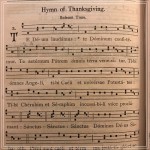
Playing Gregorian chant on wire harp (Part 4)
In one of my earlier posts on reading Gregorian chant I promised to discuss staves and clefs later on. They’re a little different in Gregorian. Modern music notation uses five lines, like this: Gregorian chant, in contrast, uses four lines: The range of Gregorian chant doesn’t usually go beyond an octave, so you won’t see […]

Playing sacred music on the Irish wire-strung harp From reading neums to playing strings...
Sing unto the Lord with the harp; with the harp, and the voice of a psalm. – Psalm 98:5 My preceding posts on reading Gregorian chant didn’t go into how to play it on the wire-strung harp. Gregorian chant is a vocal music, not an instrumental one. So there’s a little bit of re-interpretation here. […]

Playing Gregorian chant on wire harp (part 3) Beginning reading two- and three-note neum groups
Here is a very beautiful illuminated antiphonary from Bern, Switzerland, created in approx. 1485 to 1490 A.D. Most of the square neums shown here are the single note punctum type but there are also several of the two and three note groups: podatus, clivis and torculus. From the Liber Usualis, here is a chart showing us […]

Playing Gregorian chant on wire harp (part 2) Comparing neumes to modern music notation
Medieval chant neums look very different from today’s music notation… until you get to know them better and discover they’re what made the language of modern sheet music possible. They do however, have their own arcane code, which has been left by the wayside, perhaps in part because few today write anymore with quill pens and […]

Playing Gregorian chant on wire harp (Part I) Introduction and a little historical background
Every Sunday for our service prelude I play the liturgically appropriate Gregorian chant for the day from the Roman Catholic Liber Usualis (this is a fairly conservative traditional New England Episcopal church). I also play another one for the Communion, sometimes with husband George accompanying on the pipe organ. Usually I start out by playing […]
